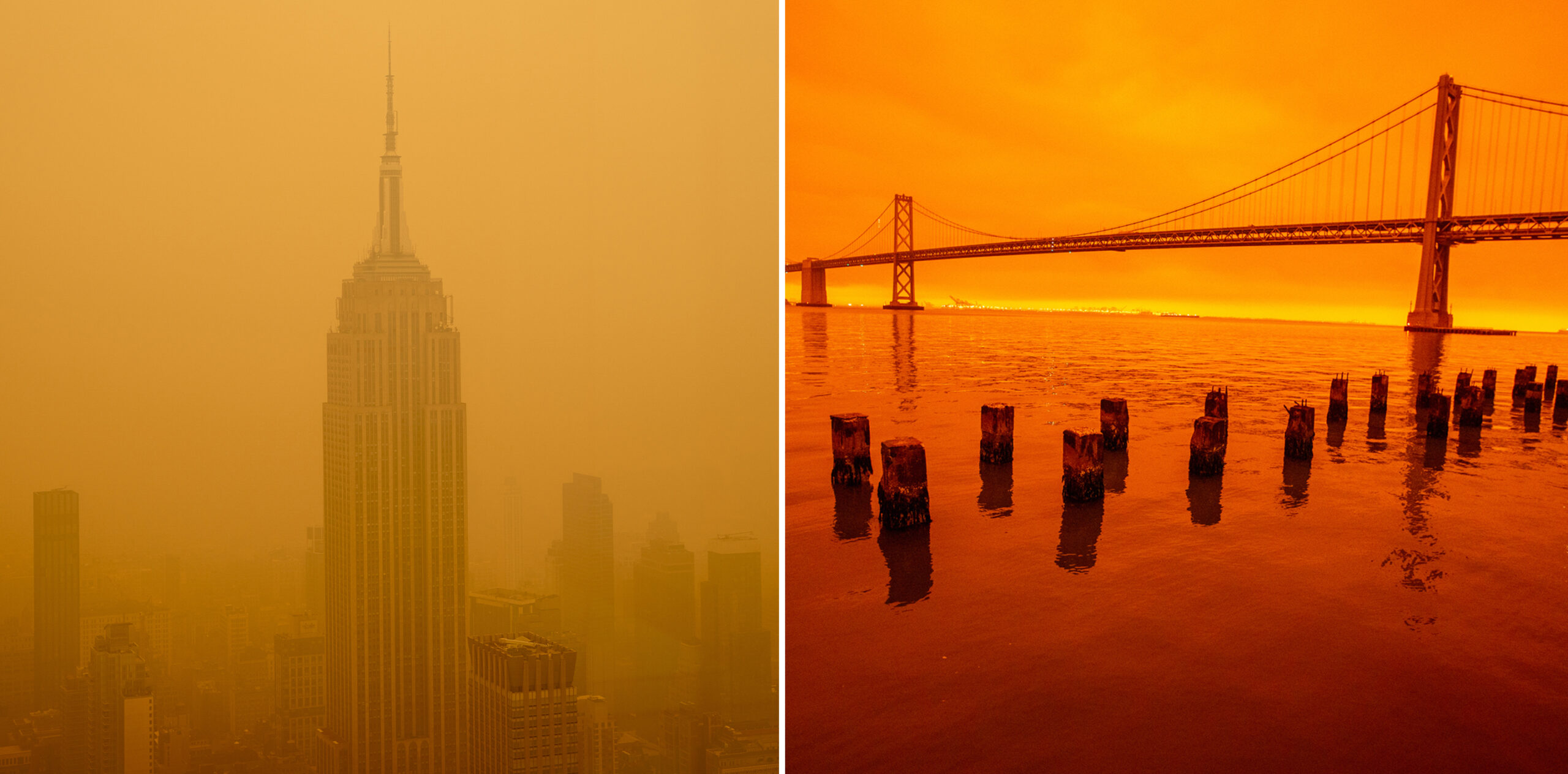The wildfire smoke currently blanketing New York and other cities in the Northeast has an eerie orange quality that’s giving San Francisco a combination of complicated camaraderie and PTSD. Who among us doesn’t remember Sept. 9, 2020, the day when San Francisco looked like Blade Runner 2049, and everyone’s Instagram lit up with pics of their next-door neighbor’s house looking haunted AF at 10 a.m.?
It’s triggering to see, for sure. On the other hand, people on the other coast have finally gotten a taste of the horrors we have come to expect every fall. Horrors that President Donald Trump blamed on insufficient raking and climate deniers everywhere attributed to California’s progressive leanings and reluctance to set controlled burns. But the planet ain’t what it used to be.
We feel your pulmonary pain, New York. Alien landscapes are one thing, but inhaling particulate matter airdropped from Canada feels like you’re shortening your life span with every panicky breath. So in the spirit of “been there, done that,” we offer some tips for how to stay sane while staying indoors.
Stay the Hell Inside. No Jogging!
To Dr. John Balmes, who teaches at the University of California San Francisco and the University of California Berkeley, the latest high-profile wildfires are a reminder there needs to be a collective doubling down of efforts to prevent the worst.
“Now people on the East Coast know what we go through in California and Oregon and Washington,” Balmes said. “Maybe there will be more support for the kind of bold climate change mitigation policies that we need.”
Fixing a broken world is important, but today, you need to stay the hell inside. Avoid the outdoors as much as possible, and don’t even think about jogging. Keep the windows closed, and ogle the atmosphere’s unsettling hues from behind double-paned glass if you can. With highs only around 70 degrees, you can probably get by without air conditioning for now. And even though it may sound ridiculous, try to minimize vacuuming and cooking on a gas stove—which, believe it or not, can make a bad situation worse.
If you’re tempted to order DoorDash, keep in mind that the working people who make the world run are going to be exposed to the particulate matter you’re protecting yourself from. Tip extra-generously!
Reintroduce Yourself to Those N-95s
By now, this is common knowledge across continents due the need for high-quality masks to prevent the spread of Covid. In the case of wildfire smoke, an N-95 mask or an equivalent is really the only type with the proper seal to prevent exposure, Dr. Balmes noted.
This is especially important when outside, both for people who must step out and workers who cannot go indoors. Many in New York caught on quick, as seen through the #MaskUp trending on Twitter this week to urge people to protect themselves.
Breathing the air for longer than an hour without a mask outside is like CHAIN SMOKING A PACK OF CIGARETTES 🚬…. be safe folks—either stay indoors & get a HEPA filter, or wear a minimum N95 mask or better yet a P100 mask if you must go outside. #MaskUp #HEPA https://t.co/37gcMKQYsD
— Eric Feigl-Ding (@DrEricDing) June 7, 2023
Check Air Quality
On Wednesday, New York saw some of the world’s worst air quality—even worse than what the Bay Area saw in September 2020. By Thursday afternoon, the Air Quality Index in the iPhone weather app said Manhattan’s levels were about 150, which is certainly unhealthy, but a far cry from the upper 400s the day before.
Even these less dramatic Air Quality Index levels can bring health troubles. At AirNow.gov, you can check the index in your immediate area to see when the air is unhealthy for sensitive groups or the general public, as well map out where fire and smoke is located in the country.
For a highly localized air reading, Anthony Wexler, University of California Davis Air Quality Research Center director, suggested buying air sensors, which are becoming cheaper, to attach to your home. The data from your sensor, which may be compiled by OpenAQ.org, can help inform overall air quality
Here’s the important part. Turn on those HEPA air purifiers and place them where you spend the most time in the home. You can also affix a MERV-13 filter to a central air unit for extra filtration, like Dr. Balmes has done in his home.
For those who can’t afford air purifiers, Wexler points to an effective DIY method developed by his colleagues. A simple box fan covered by MERV-13 filters and a cardboard base, all connected by duct tape, can be assembled with supplies found at a hardware store at a steep discount compared with machines.
Go See a Doctor—But Try Not To Become a Hypochondriac
Unfortunately for New York, the thick smoke its residents are experiencing this week due to several Canadian wildfires poses a real health issue, from risks for heart attacks and child lung development. People with asthma and preexisting lung or heart diseases will feel the effects more immediately, said University of California San Francisco researcher Dr. Raj Fadadu.
The most at-risk include elderly and pregnant people, but inflammation from wildfire can present skin issues and coughing in otherwise healthy people.
“There’s a lot we don’t know about wildfire smoke and the effects on the human body,” said Dr. Fadadu. “It’s an acute change in the environment. It might be something that’s a shock or new for our body. There’s not just physical impacts of climate change but psychological ones.”
Ultimately, there is only so much you can do for yourself and the people you love. As we all remember from the pandemic, helplessness and feeling cloistered indoors can be a stressful combination. Keep in mind that this, too, shall pass, and the sun will shine once more. If you’re really losing it, call your favorite Californian and commiserate. Odds are, we’ll be dealing with smoky skies again soon.
